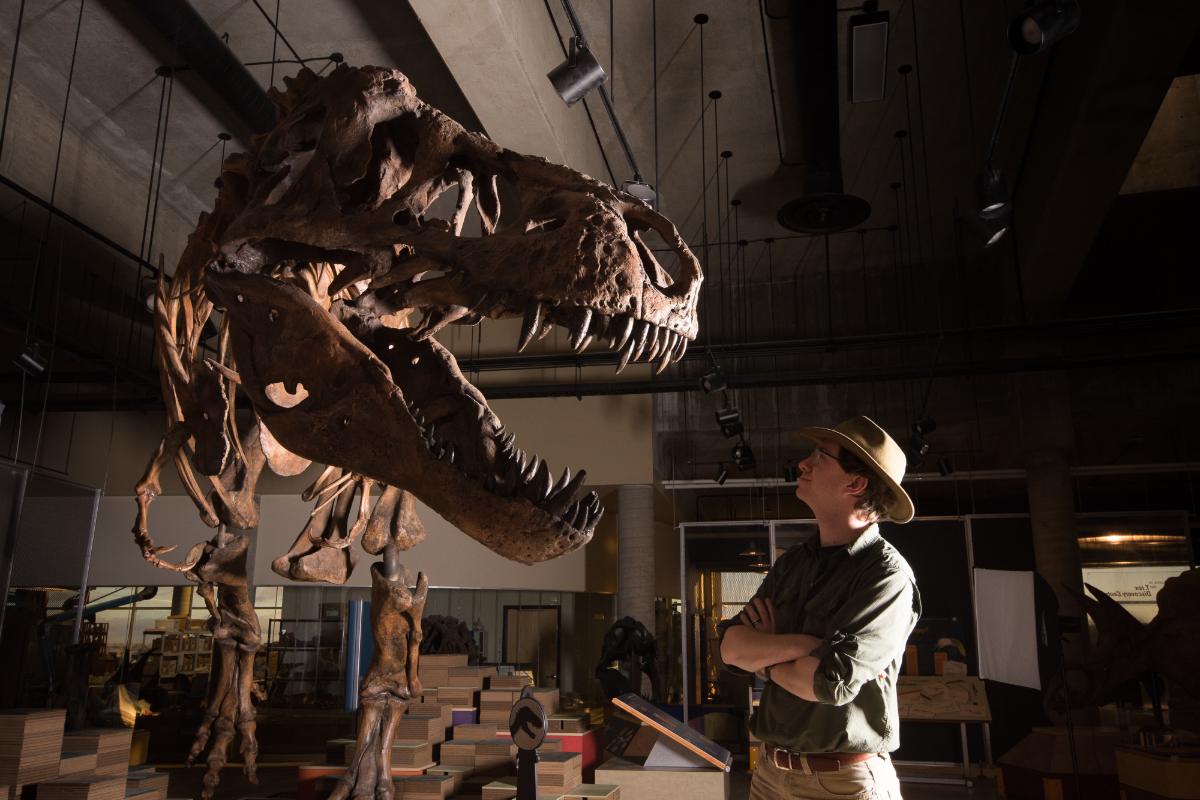
Paleontologist Scott Persons, pictured here with the recently-discovered world's largest T. rex "Scotty," led the study at UAlberta exploring how dinosaur feathers changed over time and enabled flight. Photo credit: Amanda Kelley
Paleontologists at the University of Alberta have shed new light on the evolution of feathers-how the feathers that would have once acted solely as insulation to keep dinosaurs warm became the complex flight structures we see today. The missing link between these functions? Attracting mates.
"The first complex wing feathers show up in tiny raptor dinosaurs that could parachute and glide flying-squirrel-style through the prehistoric tree tops," said Scott Persons, lead author of the study, conducted as a post-doctoral researcher in the Department of Biological Sciences. "In this study, we explore how dinosaurs went from staying warm with simple hairy feathers to gliding on complicated wing feathers."
The study makes the case that larger, stiffer, flatter feathers very gradually evolved as showy fans on the arms and tails of dinosaurs to be waved and waggled in courtship displays, leading eventually to the evolution of birds-an interpretation supported by a growing fossil record of early feathers.
"Sexual display remains an important function of complex feathers in some birds to this day," said Persons, the UAlberta alumnus who is now continuing his paleontology research at the College of Charleston. "Think of the feather fans of turkeys and peacocks or the head crest of a cockatoo."
A missing link
"Modern bird feathers are complicated," said Persons. "The feathers on a bird's wing each have a central hollow shafted called a rachis, branching filaments called barbs, and even smaller filaments called barbules-whereas fossil feathers show us that many dinosaurs were covered only in simple hair-like feathers."
Those simple feathers had nothing to do with flight, instead serving as insulation to keep dinosaurs warm.
"Going from simple hairy feathers to sophisticated flight feathers is a big jump. Evolution doesn't normally work in big jumps. It's gradual," said Persons. "Recognizing the intermediate function of sexual display explains a gradual way for simple feathers to have grown in complexity."
While the study sheds new light on the evolutionary steps leading from dinosaurs to birds, there are still rich paleontological mysteries to explore concerning fossil feathers.
"We are still missing clear examples of sexually dimorphic feathers in dinosaurs. Today, it's easy to tell the sexes of many birds apart based on their feathers," said Persons. "Male birds tend to have larger, gaudier, and brighter feathers because they are the ones doing the displaying. This was very likely true of feathered dinosaurs, but we haven't found a definitive example... yet."
The paper, "Feather evolution exemplifies sexually selected bridges across the adaptive landscape," was published in Evolution (doi: 10.1111/evo.13795).
Want to learn more about the world-class paleontology research happening at the University of Alberta? Check out our paleontology hub to keep up on the latest research news and fossil finds.